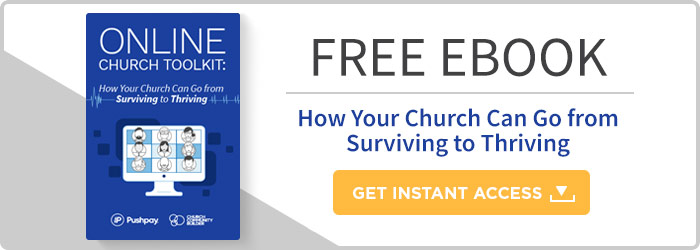
5 Ways to Help People Transition from Livestreams to In-Person Participation
Livestreaming can’t replicate the connections people make in person but for newcomers, live video can be a stepping stone to developing real relationships.
There are a lot of benefits to livestreaming your services. It serves members who can’t attend in person because they:
- Moved away for college
- Traveled out of town for work
- Were too sick to show up
- Had a last-minute emergency
- Have trouble getting around
Livestreaming also gives potential visitors a way to experience what your church is like before they commit to showing up in person. And it allows people who live in other states or countries to discover your message and participate in your service from afar.
Unlike recorded sermons, livestreams helps people feel more like participants than viewers. They’re there with you, worshiping God and experiencing the service as it unfolds.
But no matter how much of your service you film, livestreaming can’t replicate the connections people can make in person. For newcomers, livestreaming should be a stepping stone to developing real relationships with you and a physical community of believers.
Here are five ways you can help people transition from livestreaming to in-person participation.
LEARN MORE ABOUT LIVESTREAMING WITH RESI
1. Call out areas where you have lots of viewers
Hopefully, whatever video-hosting platform you’re using to livestream your service provides audience analytics, so you can see where your viewers are from. (If not, consider adding a contact form below your livestream, inviting people to tell you more about themselves.) Once you’ve identified the areas where you consistently have the most live viewers, mention them during the service and thank them for joining you. This isn’t going to send them stampeding onto your campus, but it’s an important baby step toward making your digital attendees feel valued and creating real relationships with them.
2. Dedicate a staff person to online ministry
It’ll be a lot easier to develop and execute a strategy for your online ministry if it’s someone’s job. Whether it’s a pastor, a director, or some other position, you need a staff member who can make a focused effort to connect with your online viewers. You’re going to need a balance of mass communication and personalized attention to guide people from tuning in to livestreams to developing in-person relationships. If you don’t have a real person inviting people individually, they’re a lot less likely to take a leap and ditch the screen.
3. Offer to meet with individuals for coffee
When people are used to joining your service from the comfort of their home, showing up to a service in person can feel pretty intimidating. Plus, many people likely feel like they’re already getting the whole experience with the livestream. Consider having a staff person spend a day working in a coffee shop or another public space and inviting stream regulars to stop in.
Not only is this a smaller commitment (because you’re coming to their area), but it gives you an opportunity to personally and individually connect with people who’ve been joining you via livestream. It’s off-campus office hours. Just be sure the person who’s doing this comes on camera during the service and tells your viewers where and when they can meet.
4. Host a streaming party in your most active areas
Hosting a livestreaming party is kind of like setting up a service for a brand-new satellite campus. It’s a fairly informal gathering in a public space. People get together around a screen to join your service. They have a similar experience to what they might have at home but with a greater sense of belonging and community. In order to make this happen you need a clear point person, a space and a screen you can use, and plenty of upfront communication. You should highlight the streaming party on your website a few weeks in advance and announce it during the service.
Depending on your goals and how much you put into it, a livestreaming party could evolve into small groups, physical service attendance, or potentially a full-on satellite campus.
Pro tip: If you encourage livestreamers to download your church app, you can get them more plugged in to your community and give them a convenient way to RSVP to your streaming party through the events tab.
5. Facilitate location-based small groups
Some people who livestream your services may feel like they don’t need to experience your service in person. Or maybe it’s simply too impractical for them to join you. You don’t have to fight against the grain to get them to your campus. But there’s still more you can do to nurture their member journey and encourage them to go deeper in their faith.
If you build relationships with a handful of people in a location, encourage them to start a small group—or designate a staff member or volunteer to lead a group in that area. This gives people community they simply can’t replicate through a livestream, helps them progress in their faith journey, and strengthens their connection to your church (especially if you provide curriculum).
Get the most from livestreaming
A lot of churches use livestreaming to serve their existing members and give visitors a way to test the waters. But when enough people start watching in nearby communities, livestreaming becomes a tool you can use to help people build meaningful connections to your church and develop real relationships with fellow believers.






